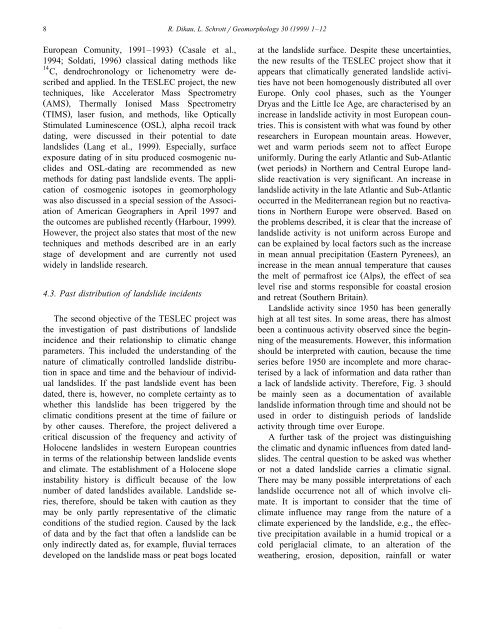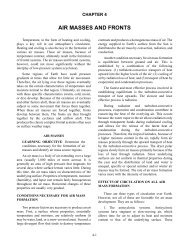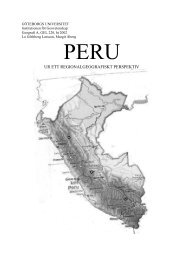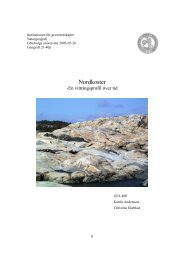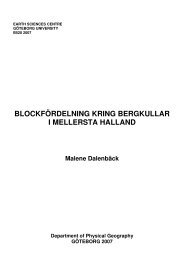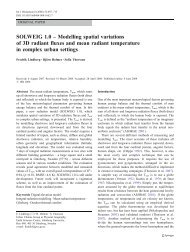The temporal stability and activity of landslides in Europe with ž ...
The temporal stability and activity of landslides in Europe with ž ...
The temporal stability and activity of landslides in Europe with ž ...
Create successful ePaper yourself
Turn your PDF publications into a flip-book with our unique Google optimized e-Paper software.
8<br />
<strong>Europe</strong>an Comunity, 1991–1993. ŽCasale<br />
et al.,<br />
1994; Soldati, 1996. classical dat<strong>in</strong>g methods like<br />
14<br />
C, dendrochronology or lichenometry were described<br />
<strong>and</strong> applied. In the TESLEC project, the new<br />
techniques, like Accelerator Mass Spectrometry<br />
Ž AMS . , <strong>The</strong>rmally Ionised Mass Spectrometry<br />
Ž TIMS . , laser fusion, <strong>and</strong> methods, like Optically<br />
Stimulated Lum<strong>in</strong>escence Ž OSL . , alpha recoil track<br />
dat<strong>in</strong>g, were discussed <strong>in</strong> their potential to date<br />
l<strong>and</strong>slides Ž Lang et al., 1999 . . Especially, surface<br />
exposure dat<strong>in</strong>g <strong>of</strong> <strong>in</strong> situ produced cosmogenic nuclides<br />
<strong>and</strong> OSL-dat<strong>in</strong>g are recommended as new<br />
methods for dat<strong>in</strong>g past l<strong>and</strong>slide events. <strong>The</strong> application<br />
<strong>of</strong> cosmogenic isotopes <strong>in</strong> geomorphology<br />
was also discussed <strong>in</strong> a special session <strong>of</strong> the Association<br />
<strong>of</strong> American Geographers <strong>in</strong> April 1997 <strong>and</strong><br />
the outcomes are published recently Ž Harbour, 1999 . .<br />
However, the project also states that most <strong>of</strong> the new<br />
techniques <strong>and</strong> methods described are <strong>in</strong> an early<br />
stage <strong>of</strong> development <strong>and</strong> are currently not used<br />
widely <strong>in</strong> l<strong>and</strong>slide research.<br />
4.3. Past distribution <strong>of</strong> l<strong>and</strong>slide <strong>in</strong>cidents<br />
<strong>The</strong> second objective <strong>of</strong> the TESLEC project was<br />
the <strong>in</strong>vestigation <strong>of</strong> past distributions <strong>of</strong> l<strong>and</strong>slide<br />
<strong>in</strong>cidence <strong>and</strong> their relationship to climatic change<br />
parameters. This <strong>in</strong>cluded the underst<strong>and</strong><strong>in</strong>g <strong>of</strong> the<br />
nature <strong>of</strong> climatically controlled l<strong>and</strong>slide distribution<br />
<strong>in</strong> space <strong>and</strong> time <strong>and</strong> the behaviour <strong>of</strong> <strong>in</strong>dividual<br />
l<strong>and</strong>slides. If the past l<strong>and</strong>slide event has been<br />
dated, there is, however, no complete certa<strong>in</strong>ty as to<br />
whether this l<strong>and</strong>slide has been triggered by the<br />
climatic conditions present at the time <strong>of</strong> failure or<br />
by other causes. <strong>The</strong>refore, the project delivered a<br />
critical discussion <strong>of</strong> the frequency <strong>and</strong> <strong>activity</strong> <strong>of</strong><br />
Holocene l<strong>and</strong>slides <strong>in</strong> western <strong>Europe</strong>an countries<br />
<strong>in</strong> terms <strong>of</strong> the relationship between l<strong>and</strong>slide events<br />
<strong>and</strong> climate. <strong>The</strong> establishment <strong>of</strong> a Holocene slope<br />
<strong>in</strong><strong>stability</strong> history is difficult because <strong>of</strong> the low<br />
number <strong>of</strong> dated l<strong>and</strong>slides available. L<strong>and</strong>slide series,<br />
therefore, should be taken <strong>with</strong> caution as they<br />
may be only partly representative <strong>of</strong> the climatic<br />
conditions <strong>of</strong> the studied region. Caused by the lack<br />
<strong>of</strong> data <strong>and</strong> by the fact that <strong>of</strong>ten a l<strong>and</strong>slide can be<br />
only <strong>in</strong>directly dated as, for example, fluvial terraces<br />
developed on the l<strong>and</strong>slide mass or peat bogs located<br />
( )<br />
R. Dikau, L. SchrottrGeomorphology 30 1999 1–12<br />
at the l<strong>and</strong>slide surface. Despite these uncerta<strong>in</strong>ties,<br />
the new results <strong>of</strong> the TESLEC project show that it<br />
appears that climatically generated l<strong>and</strong>slide activities<br />
have not been homogenously distributed all over<br />
<strong>Europe</strong>. Only cool phases, such as the Younger<br />
Dryas <strong>and</strong> the Little Ice Age, are characterised by an<br />
<strong>in</strong>crease <strong>in</strong> l<strong>and</strong>slide <strong>activity</strong> <strong>in</strong> most <strong>Europe</strong>an countries.<br />
This is consistent <strong>with</strong> what was found by other<br />
researchers <strong>in</strong> <strong>Europe</strong>an mounta<strong>in</strong> areas. However,<br />
wet <strong>and</strong> warm periods seem not to affect <strong>Europe</strong><br />
uniformly. Dur<strong>in</strong>g the early Atlantic <strong>and</strong> Sub-Atlantic<br />
Ž wet periods. <strong>in</strong> Northern <strong>and</strong> Central <strong>Europe</strong> l<strong>and</strong>slide<br />
reactivation is very significant. An <strong>in</strong>crease <strong>in</strong><br />
l<strong>and</strong>slide <strong>activity</strong> <strong>in</strong> the late Atlantic <strong>and</strong> Sub-Atlantic<br />
occurred <strong>in</strong> the Mediterranean region but no reactivations<br />
<strong>in</strong> Northern <strong>Europe</strong> were observed. Based on<br />
the problems described, it is clear that the <strong>in</strong>crease <strong>of</strong><br />
l<strong>and</strong>slide <strong>activity</strong> is not uniform across <strong>Europe</strong> <strong>and</strong><br />
can be expla<strong>in</strong>ed by local factors such as the <strong>in</strong>crease<br />
<strong>in</strong> mean annual precipitation Ž Eastern Pyrenees . , an<br />
<strong>in</strong>crease <strong>in</strong> the mean annual temperature that causes<br />
the melt <strong>of</strong> permafrost ice Ž Alps . , the effect <strong>of</strong> sea<br />
level rise <strong>and</strong> storms responsible for coastal erosion<br />
<strong>and</strong> retreat Ž Southern Brita<strong>in</strong> . .<br />
L<strong>and</strong>slide <strong>activity</strong> s<strong>in</strong>ce 1950 has been generally<br />
high at all test sites. In some areas, there has almost<br />
been a cont<strong>in</strong>uous <strong>activity</strong> observed s<strong>in</strong>ce the beg<strong>in</strong>n<strong>in</strong>g<br />
<strong>of</strong> the measurements. However, this <strong>in</strong>formation<br />
should be <strong>in</strong>terpreted <strong>with</strong> caution, because the time<br />
series before 1950 are <strong>in</strong>complete <strong>and</strong> more characterised<br />
by a lack <strong>of</strong> <strong>in</strong>formation <strong>and</strong> data rather than<br />
a lack <strong>of</strong> l<strong>and</strong>slide <strong>activity</strong>. <strong>The</strong>refore, Fig. 3 should<br />
be ma<strong>in</strong>ly seen as a documentation <strong>of</strong> available<br />
l<strong>and</strong>slide <strong>in</strong>formation through time <strong>and</strong> should not be<br />
used <strong>in</strong> order to dist<strong>in</strong>guish periods <strong>of</strong> l<strong>and</strong>slide<br />
<strong>activity</strong> through time over <strong>Europe</strong>.<br />
A further task <strong>of</strong> the project was dist<strong>in</strong>guish<strong>in</strong>g<br />
the climatic <strong>and</strong> dynamic <strong>in</strong>fluences from dated l<strong>and</strong>slides.<br />
<strong>The</strong> central question to be asked was whether<br />
or not a dated l<strong>and</strong>slide carries a climatic signal.<br />
<strong>The</strong>re may be many possible <strong>in</strong>terpretations <strong>of</strong> each<br />
l<strong>and</strong>slide occurrence not all <strong>of</strong> which <strong>in</strong>volve climate.<br />
It is important to consider that the time <strong>of</strong><br />
climate <strong>in</strong>fluence may range from the nature <strong>of</strong> a<br />
climate experienced by the l<strong>and</strong>slide, e.g., the effective<br />
precipitation available <strong>in</strong> a humid tropical or a<br />
cold periglacial climate, to an alteration <strong>of</strong> the<br />
weather<strong>in</strong>g, erosion, deposition, ra<strong>in</strong>fall or water


